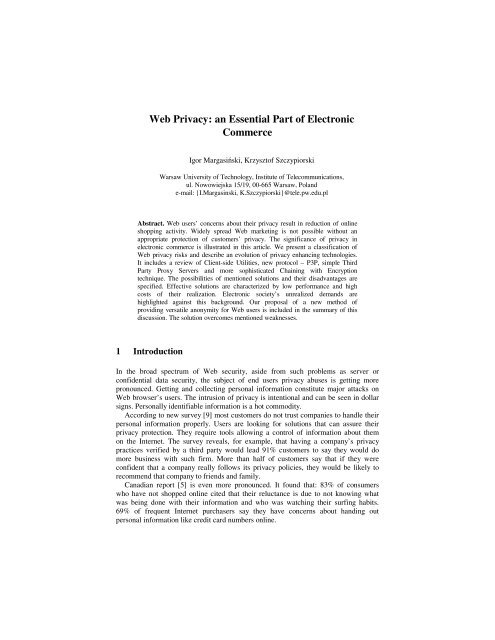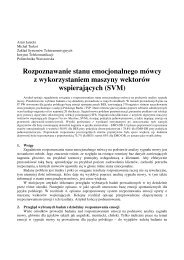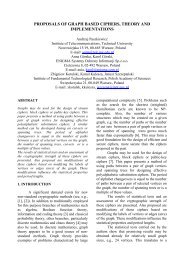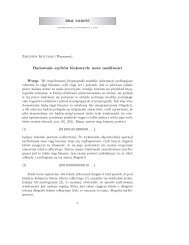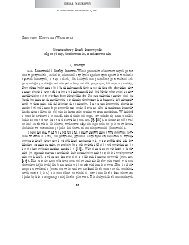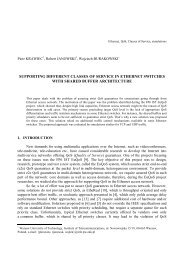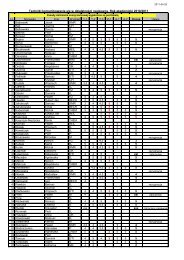Web Privacy - Krzysztof Szczypiorski
Web Privacy - Krzysztof Szczypiorski
Web Privacy - Krzysztof Szczypiorski
You also want an ePaper? Increase the reach of your titles
YUMPU automatically turns print PDFs into web optimized ePapers that Google loves.
<strong>Web</strong> <strong>Privacy</strong>: an Essential Part of ElectronicCommerceIgor Margasiski, <strong>Krzysztof</strong> <strong>Szczypiorski</strong>Warsaw University of Technology, Institute of Telecommunications,ul. Nowowiejska 15/19, 00-665 Warsaw, Polande-mail: {I.Margasinski, K.<strong>Szczypiorski</strong>}@tele.pw.edu.plAbstract. <strong>Web</strong> users’ concerns about their privacy result in reduction of onlineshopping activity. Widely spread <strong>Web</strong> marketing is not possible without anappropriate protection of customers’ privacy. The significance of privacy inelectronic commerce is illustrated in this article. We present a classification of<strong>Web</strong> privacy risks and describe an evolution of privacy enhancing technologies.It includes a review of Client-side Utilities, new protocol – P3P, simple ThirdParty Proxy Servers and more sophisticated Chaining with Encryptiontechnique. The possibilities of mentioned solutions and their disadvantages arespecified. Effective solutions are characterized by low performance and highcosts of their realization. Electronic society’s unrealized demands arehighlighted against this background. Our proposal of a new method ofproviding versatile anonymity for <strong>Web</strong> users is included in the summary of thisdiscussion. The solution overcomes mentioned weaknesses.1 IntroductionIn the broad spectrum of <strong>Web</strong> security, aside from such problems as server orconfidential data security, the subject of end users privacy abuses is getting morepronounced. Getting and collecting personal information constitute major attacks on<strong>Web</strong> browser’s users. The intrusion of privacy is intentional and can be seen in dollarsigns. Personally identifiable information is a hot commodity.According to new survey [9] most customers do not trust companies to handle theirpersonal information properly. Users are looking for solutions that can assure theirprivacy protection. They require tools allowing a control of information about themon the Internet. The survey reveals, for example, that having a company’s privacypractices verified by a third party would lead 91% customers to say they would domore business with such firm. More than half of customers say that if they wereconfident that a company really follows its privacy policies, they would be likely torecommend that company to friends and family.Canadian report [5] is even more pronounced. It found that: 83% of consumerswho have not shopped online cited that their reluctance is due to not knowing whatwas being done with their information and who was watching their surfing habits.69% of frequent Internet purchasers say they have concerns about handing outpersonal information like credit card numbers online.
2 Igor Margasiski, <strong>Krzysztof</strong> <strong>Szczypiorski</strong>This contribution is mostly a review paper. Our goal was to describe a spectrum ofpresent anonymity solutions as tools for <strong>Web</strong> privacy, help to realize their deficiencyand to point directions of require development. The last part of paper includes aproposal of original solution which overcomes described weaknesses.2 <strong>Privacy</strong> RisksThe World Wide <strong>Web</strong> (WWW) – in its present shape – does not provide adequateprivacy protection. We are now witnessing growing privacy’s endangerment. Theincreasing number of commerce applications makes personal data a marketable good.We can see a progress both in Internet technology and electronic commerce, but a gapin protection of our right to privacy remains. Today, big specialized companies are themajor drivers in utilization of this technology gap to their own advantage. Howeverthese practices effectually spoil electronic market and scare customers away fromonline shopping. The privacy risks should be examined from few different angles.Depending on placement, they can be divided into: internal, communication linkoriginated and <strong>Web</strong> server originated.2.1 Internal RisksHere, the main problem is an access to users’ personal data and <strong>Web</strong> activityinformation (for example visited websites) for local network administrators,employers or other third parties like Internet service providers. What is moreimportant, the URL (Uniform Resource Locator) addresses can inform not only aboutwhich sites were visited by a user but also about the way he filled out HTML(HyperText Markup Language) forms. This takes place when using method GET ofHTTP (HyperText Transfer Protocol) protocol [1], [6].2.2 Communication Link Originated RisksThe second point is the risks from the communication link, with the major attack –sniffing. The main protocol in WWW system is HTTP. Its security is based only onreliability of TCP/IP (Transmission Control Protocol / Internet Protocol) protocolsuite and does not forecast possibility of attacks. User should than take into accountthe fact, that information about visited sites and data from completed forms can beeasily accessed also by other Internet users. According to Harris Interactive report [9]:70% of customers claim that their major concern about online shopping is that <strong>Web</strong>transactions may not be secure and 69% that hackers could steal their personal data.2.3 <strong>Web</strong> Server Originated RisksThe last issue is the risks related to the <strong>Web</strong> server. The danger lays in the fact thatthe website can obtain a wide range of information about a client. Server gets client IP
<strong>Web</strong> <strong>Privacy</strong>: an Essential Part of Electronic Commerce 3while establishing connection. The origin of each individual request and itsassociation with each host are known to a server. A standard practice for mostwebsites is to log HTTP requests to their <strong>Web</strong> server. This means that owners ofwebsite know the originating IP address of a user agent requesting a URL. They alsohave access to: date of request, realization time, user's name – HTTP identification,information about errors of HTTP transaction, referrer link, user-agent information.Sending a URL address of previously visited page (referrer link) to a serverconstitutes a major privacy violation. In spite HTTP specification, which says that theavailability of information about referrer link should be optional, not one existing useragent did in fact incorporate the possibility of turning off this mechanism. Thesignificance of this violation is more pronounced because the URI (Uniform ResourceIdentifier) address can often contain data from HTML forms. An URI string may inparticular contain keywords introduced into <strong>Web</strong> search engines.The next tool, which can be used to take privacy away from users, is statemanagement mechanism – Cookies [10]. This technique was introduced to allow, instateless protocol (i.e. HTTP), a differentiation between persons visiting a server.Cookies mechanism has realized its new uses, not thought of by its creators. Todaywe can observe the utilization of this mechanism to create and enlarge databases withdetail users’ profiles. Let’s follow a typical process of creating a profile. We can findbanner ads on many websites. Mostly in the form of bitmap images or Shockwaveanimations, which come from profile creating third party (Ad Server). When visitingsuch page, in reality we are receiving banner ad from Ad Server, although the userdoes not know this. Our IP address is being automatically sent to the third party (AdServer). Next, a Cookie information is placed. Ad Server writes information about us,such as the date, time and address of the visited page. We are identified by an IDnumber. The are many <strong>Web</strong> pages, which require registration before accessing sameservices. In the registration process we release personal identity information likename, e-mail address and so on. The registration page sends all the information to AdServer, which creates more detailed information database, updated every time we visitpages in the banner ad network. Information gathered this way is used by banner adnetwork pages to target specific commercial recipients, to create personal e-mailoffers and spam or to breach privacy even further. In user agent default settingscookie mechanism is invisible to users. The statistics [9] showed that the main (75%)concern expressed by customers is that companies they patronize will provide theirinformation to other companies without their permission. We should also mentionrisks created by programs executed on client machines. They may be so called TrojanHorses, because they, in a way unnoticeable to users, send information about them.All the presented growing risks make new requirements necessary to establish.<strong>Web</strong> users should have a choice to provide or not to provide their personal data.3 Current SolutionsTwo types of solutions are dominant in ordinary use. They are: Client-sideApplications and Proxy Servers.
<strong>Web</strong> <strong>Privacy</strong>: an Essential Part of Electronic Commerce 5inputs and outputs (proxy server request). A very serious risk also exists here, becauseit is possible for third parities to track and profile users. The next disadvantage ofproxy servers is the limitation of sets of elements which can be downloaded. Some ofHTML standard enhancements (like JavaScript) can create high risks for the wholesystem. It is possible and easy to perform powerful attacks using these technologies.The mentioned attacks can completely compromise proxy sever systems. Presentedsecurity gaps should provoke further conceptual and design studies.3.3 New Protocol – P3PThe P3P – Platform for <strong>Privacy</strong> Preferences Protocol [3] is promoted to be a newstandard. Its main task is privacy protection of people surfing in WWW system. P3Pintroduces uniform and machine-readable format for websites privacy policies and foruser’s private data collected by his <strong>Web</strong> browser. Thanks to this user can easilyfamiliarize himself with visited websites privacy statements. User’s browser is able toread this statement and automatically decide, for example, if to send users idinformation or if to allow for Cookies.This protocol is a useful tool in electronic commerce both for merchant and client.P3P can help achieve harmony between companies’ economical needs for informationrequired to provide services and customers’ rights to privacy and control overpersonal information. P3P technology can also decrease practices of profiling.However it is well known, that this mechanism cannot provide full privacy. It is notpossible to hide all user agent id data – for example IP address.The newest <strong>Web</strong> browsers are equipped in Platform for <strong>Privacy</strong> PreferencesProtocol client. For now this is mostly experimental – there are few <strong>Web</strong> pages withP3P technology support.3.4 Adaptation of Chaining with Encryption TechniqueMore or less adequate adaptation of Chaumian concept to WWW system was alreadyimplemented by few organizations. Examples of systems based on MIXNET include:Onion Routing [14], [8], Crowds [13], Freedom [7] (first profitable system of thiskind). They are all based on a network of proxy nodes. Data packets are divided intouniform length frames (for example 128 bytes). Every frame is encrypted repeatedlyand then send on its winding way.To accomplish encryption and decryption of exchanged packets these systems useadditional software executed on user’s computer. This software takes over allcommunication with Internet and rerouting packets to service servers. Usually thesystems also provide anonymous access to another services such as email, news, filesharing.The popularity of this type of systems is limited. Systems based on chaining withencryption do not eliminate all risks of traffic analysis attacks. Anonymity is stilldependent on a third party – information about user’s <strong>Web</strong> activity was only dispersedbetween many proxies. However, there is no certainty that proxies do not collaboratewith each other. What is more, anonymity service provider cannot submit a proof that
<strong>Web</strong> <strong>Privacy</strong>: an Essential Part of Electronic Commerce 7users <strong>Web</strong> activity – by requesting random websites from proxy. The basis of thissolution is the observation of a typical <strong>Web</strong> navigation. User does not requestwebsites at all times. Requests get sent in various time intervals and in between them,the user reads the content. VAST utilizes this fact. Additionally, VAST takes advantageof the simplicity of generating dummy traffic in WWW system – we mean that a widerange of Internet resources is indexed in <strong>Web</strong> search engines. We can simulate user’sactivity using it. The VAST system, unlike other existing solutions, does not conductadditional major activity while the transaction takes place, but it utilizes free time totake actions providing versatile anonymity. A source code of agent applet would beavailable to all. Then users would be able to check if it is not a Trojan Horse.4.2 VAST PerformancePresented idea was designed to allow high performance – similar to efficiency oftraditional <strong>Web</strong> browsing. All additional processing intended to provide anonymitytakes place not at the time of requesting or downloading page, but at the time whenuser reads/watches downloaded pages. However, there is still a question: how dummytraffic delays browsing? Sometimes a user familiarizes him with page content fast.How long must he wait than? VAST can block all content which comes from the thirdside servers. This means excluding all multimedia banner ads placed frequently onmany sites. Statistic analyses show that size of ads placed on popular websites andportals often occupies 50% of total website size or even more. Requests to third sideservers are replaced by dummy traffic requests in VAST system.The volume of dummy traffic should be on a proper level to perform effectivemasking of user’s activity. The number of transactions performed in appropriatesessions should be approximately equal. Let τ d denotes average time of downloadingof single <strong>Web</strong>page; τ f – average time of familiarizing with page content; τ w – averagedelay of <strong>Web</strong>page downloading introduced by VAST system in comparison totraditional proxy server; n – number of dummy sessions. Then the delay τ w can bedescribed as follows:τ w = 0.5 τ d for τ f n τ d (1)τ w = n τ d – τ f + 0.5τ d for τ f < n τ d (2)This can be written:| n τ d – τ f | + (n+1) τ d – ττ fw =(3)2The following results can be obtained for a typical downloading time τ d = 8 [s]:Table 1. Delays introduced by VAST (τ w ) system as a function of user’s familiarizing with<strong>Web</strong> content timen τ f [s] 0 1 2 3 4 5 6 7 8 9 10 11 12 13 14 15 16 17 18 19 201 τ w [s] 12 11 10 9 8 7 6 5 4 4 4 4 4 4 4 4 4 4 4 4 42 τ w [s] 20 19 18 17 16 15 14 13 12 11 10 9 8 7 6 5 4 4 4 4 4The computations shows that acceptable delays (similar to delays present intraditional anonymous proxy server systems) occur when users spend time tofamiliarize with <strong>Web</strong>page content equal to multiplication of a number of sessions anda single page download time.
8 Igor Margasiski, <strong>Krzysztof</strong> <strong>Szczypiorski</strong>5 SummaryToday’s popular tools are not perfect. They do not provide full anonymity. Newproposals are not able to reach a wider audience. Technology based on network ofChaum’s nodes is successful in electronic mail. It does not mean that it is directlyapplicable to WWW, which has different requirements (most of all speed). Ourproposition of solving this problem is the system dedicated to WWW. The concept isbased on its characteristic and utilizes it. This comprehensive technique overcomesweaknesses of existing systems such as: serious, noticeable delays, access of serviceprovider to user’s private data and high costs of service implementation. The novelidea in this system – dummy traffic generation – may be in some cases viewed as itsweakness. For users, whose fees for the Internet access are based on the amount ofdownloaded data, it means higher costs. We should stress that the system can blockthird party servers advertisement elements. It means that the graphic files from thirdparties are exchanged for dummy traffic.References1. Berners-Lee, T., Fielding, R., Frystyk, H.: Hypertext Transfer Protocol – HTTP/1.0. RFC1945 (1996)2. Chaum, D.: Untraceable Electronic Mail, Return Addresses, and Digital Pseudonyms.Communications of the ACM Vol. 24 no 2 (1981) 84 - 883. Cranor, L., Langheinrich, M., Marchiori, M., Presler-Marchall, M.: The Platform forPreferences 1.0 (P3P 1.0) Specification, W3C Recommendation (2002)4. Dierks T., Allen C.: The TLS-Protocol Version 1.0. RFC 2246 (1999)5. Ferneyhough, C.: Online Security and <strong>Privacy</strong> Concerns on the Increase in Canada, Ipsos-Reid (2001)6. Fielding, R., Gettys, J.,Mogul, J., Frystyk, H., Masinter, L., Leach, P., Berners- Lee T.:HyperText Transfer Protocol – HTTP/1.1. RFC 2616 (1999)7. Goldberg, I., Shostack, A.: Freedom Network 1.0 Architecture and Protocols. Zero-Knowledge Systems. White Paper (1999)8. Goldschlag, D. M., Reed, M. G., Syverson, P. F.: Onion Routing for Anonymous andPrivate Internet Connections. Communications of the ACM Vol. 42 no 2 (1999) 39-419. Krane, D., Light, L., Gravitch D.: <strong>Privacy</strong> On and Off the Internet: What Consumers Want.Harris Interactive (2002)10. Kristol, R., Montulli, L.: HTTP State Management Mechanism. RFC 2965 (2000)11. Margasiski, I., <strong>Szczypiorski</strong>, K.: VAST: Versatile Anonymous System for <strong>Web</strong> Users.The Tenth International Multi-Conference on Advanced Computer Systems ACS'2003(2003)12. Martin, D., Schulman, A.: Deanonymizing Users of the Safe<strong>Web</strong> Anonymizing Service.<strong>Privacy</strong> Foundation, Boston University (2002)13. Presler-Marshall, M.: The Platform for <strong>Privacy</strong> Preferences 1.0 Deployment Guide, W3CNote (2001)14. Reiter, M.K., Rubin, A.D.: Crowds: Anonymity for <strong>Web</strong> Transactions. ACM Transactionson Information and System Security (1998) 66-9215. Syverson, P. F., Goldschlag, D. M., Reed, M. G.: Anonymous Connections and OnionRouting. IEEE Symposium on Security and <strong>Privacy</strong> (1998)


